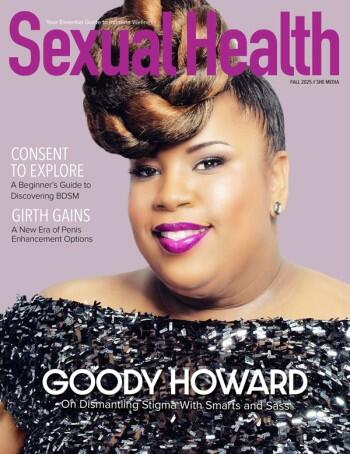What sort of sexciting books do you have at your bedside? Do you have a well-thumbed copy of “Fifty Shades of Grey?” Or perhaps a story that shook the country such as “Lady Chatterley’s Lover?” Or Highland passions — and kilts — courtesy of “Outlander?”
But what if you’re busy worrying about your sexy business rather than imagining ... ahem … getting down to business, so to speak? Fear not: this month I’m here to help with five (six, really) top marketing titles for non-marketing pros to be reading without excuse in order to help inject some oomph into your erotic retailing business.
This month I’m here to help with five (six, really) top marketing titles for non-marketing pros to be reading without excuse in order to help inject some oomph into your erotic retailing business.
While the erotic retailing sector has some great brands, there’s also a fair few less than great ones. And, sorry to break some hearts here, some absolute stinkers too. And as brand identity (and branding as a whole) is arguably the most noticeable aspect of a company’s marketing, it’s as good a place to start as any.
“The 22 Immutable Laws of Branding” by Al and Laura Ries is recommended as your start point for a few reasons. In direct contrast to a great many marketing tomes that also make excellent doorstops, this paperback’s diminutive size means it can easily slip into your laptop bag or handbag even if you want a bit of reading on your morning commute.
But don’t think for one minute that size comes at the expense of substance. Each Law — ranging from brand extension (not a good idea: “the easiest way to destroy a brand is to put its name on everything”) to color (“You have probably seen many more Miller cans than Tiffany boxes, but we would bet that you know the hue of a Tiffany box and that you’re not quite sure about Miller.”) — is well supported, calling upon a plethora of examples involving famous brands across multiple industries to hammer each point home. It’s a cracking book, one of two which I always make sure I have in my bag on a work trip to kill time either mid-flight or when invariably delayed at the gate.
And the second book I have with me? It’s another book co-written by Al Ries (yes, he’s a bit of a marketing expert) simply titled “Positioning.” And like its stablemate above, it’s similarly sized so it’s perfect for shoving into your bag. While Ries and co-author Jack Trout originally wrote about positioning back in 1972, it was arguably this book’s publication eight years later that really propelled the concept into the marketing stratosphere.
Unfortunately, just like branding, positioning isn’t afforded the respect it deserves (particularly by non-marketers), probably due to lack of understanding than anything else. To remove any semblance of doubt, in the authors’ own words, “Positioning starts with a product … But positioning is not what you do with a product. Positioning is what you do to the mind of the prospect. That is, you position the product in the mind of the prospect.”
And from there on in, you’re given a masterclass in how to make a real impact in the minds of consumers. If you’re not the first or the biggest in a category, invent a new category (or “creneau”) that you can be. But what if there are no more creneaus to fill? You reposition the competition instead. Such insight is pure gold for anyone trying to compete in the noisy, overcrowded marketplace like ours.
I’ll happily stick my neck out here and emphasize that if you only have the budget to buy a couple of books from the ones I’ve selected, make it these first two. You won’t regret it for a minute.
The third book on my top five list for small companies (below 250 employees) and micro businesses comes from Joe Pulizzi, the founder of the Content Marketing Institute. “Content Inc” (published 2015) is a great book that breaks down the steps entrepreneurs need to take to build significant audiences through content marketing. And how does the author know? Because he effectively reverse engineered the process that successful entrepreneurs (from around the world) had adopted and identified clear steps to be taken.
While the book clearly introduces and elaborates on key concepts such as sweet spots and content tilts and takes you through each step of the way, perhaps the biggest takeaway is this: build your audience first. And do so consistently. Furthermore, extinguish any wild notions that content marketing is going to make you an overnight “sexcess”: it won’t. What it will do for sure is help you steadily build your audience and increase engagement to the benefit of your business.
Fourth on the list is another co-authored effort: “More Guerrilla Marketing Research” by Robert Kaden and Gerald Linda. Having seen more heinous “surveys” from ignorant lingerie and sex toy retailers than I care to admit (I’ve written about this on various occasions), I can’t recommend this enough as a book for non-research professionals to be able to grasp the key elements of marketing research – including survey design – and consequently understand what’s required to conduct a beneficial marketing research program.
Whether your customer research is qualitative or quantitative, outsourced or in-house, this is the book you have to read to ensure any research conducted is worth the time and money put into it and actually delivers key insight to decision makers. While many marketing research books will undoubtedly scare non-researchers away with detailed chapters on sampling and statistical techniques (it scares some professional researchers too, I’m sure) in contrast Kaden and Linda’s contribution is both well appreciated and well needed.
My final book isn’t a marketing book per se, but has tremendous relevance. Professor Robert Cialdini’s 1984 book “Influence: The Psychology of Persuasion” remains a seminal tome to this day, identifying six key principles instrumental to successful influencing and persuading, including reciprocity, social proofing, commitment, and authority. This isn’t some dry academic theorizing: Cialdini went undercover in a number of different jobs to see — and learn — for himself these principles in action. And while his book was originally written long before we were glued to smartphones and living our lives online, the six principles can easily be implemented, whether it be in your web content, landing pages, social media — or offline in B2B sales, for instance. Try them out for yourselves and see what effects they have on your business.
It would be remiss of me not to mention that 32 years later after the publication of “Influence,” the man described as having “more degrees than a thermometer” was back. Cialdini’s latest offering from 2016, “Pre-suasion: A Revolutionary Way to Influence and Persuade” contends that it isn’t merely the message that matters, but the time immediately preceding it, where the recipient can be “primed’ to be more receptive. One example cites the use of playing French music in order to help consumers choose a bottle of French wine (I guess for a BDSM or fetish boutique this should be replaced by Nine Inch Nails’ “Closer” or Alice Cooper’s “Bed of Nails”). And while the jury is out in some quarters regarding the validity of priming research (mostly due to methodological issues) it’s certainly worth thinking about. At the end of the day, anything legal and legitimate to help consumers reach into their wallet or purse to shop, and shop with you rather than with your rivals, has got to be worth looking into — even if just to see what the hubbub is about.
So, once you’ve finished reading this edition of XBIZ Premiere, you know what you should be reaching for next!
Brian Gray is the founder and head consultant at Lascivious Marketing, based in Glasgow, U.K. With two decades of marketing experience in a variety of roles and industry sectors, Gray helps manufacturers, wholesalers and retailers in the erotic industry improve their marketing performance through strong brand creation, better customer understanding and insight, tailored marketing planning and communications through focused effort. He was also the founder of the XBIZ.net London Gathering networking events back in 2010. Gray can be contacted at lasciviousmarketing.com, found on Twitter @LasciviousMktng and XBIZ.net or phoned on +44 (0)141 255 0769.








